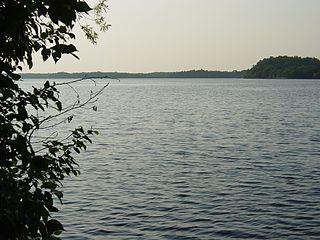
Itasca County is a county located in the State of Minnesota. As of the 2010 United States Census, the population was 45,058. Its county seat is Grand Rapids. The county is named after Lake Itasca, which is in turn a shortened version of the Latin words veritas caput, meaning 'truth' and 'head', a reference to the source of the Mississippi River. Portions of the Bois Forte and Leech Lake Indian reservations are in the county.

Aitkin County is a county in the U.S. state of Minnesota. As of the 2010 United States Census, the population was 16,202. Its county seat is Aitkin. Part of the Mille Lacs Indian Reservation is in the county. The county was created in 1857 and organized in 1871.

Tamarack is a city in Aitkin County, Minnesota, United States. The population was 94 at the 2010 census.

Mille Lacs Kathio State Park, also known as Kathio Site, is a Minnesota state park on Mille Lacs Lake. The park preserves habitation sites and mound groups, believed to date between 3000 BC and 1750 AD, that document Sioux Indian culture and Ojibwe-Sioux relationships. The park contains 19 identified archaeological sites, making it one of the most significant archaeological collections in Minnesota. The earliest site dates to the Archaic period and shows evidence of copper tool manufacture. The Sioux lived in this area roughly until the 18th century, when many bands of Sioux were moving southward into the prairies and river areas of southern Minnesota. At the same time, Ojibwe (Anishinaabe) were moving in from the east. Ojibwe oral tradition, published by William Whipple Warren, suggests that there was a battle in which they successfully took control of the area from the Sioux; as of 2012 no archaeological evidence has as yet been found to corroborate this battle narrative.
Tamarack is a common name for Larix laricina, a medium-size species of larch tree native to North America.
The Little Fork River is a river of Minnesota. It flows into the Rainy River.
The Little Hill River is a river of Minnesota.
The Little Willow River is a 26.2-mile-long (42.2 km) tributary of the Mississippi River in northern Minnesota, United States. It rises in western Aitkin County at the outlet of Esquagamah Lake and flows generally south to its junction with the Mississippi River 3 miles (5 km) northwest of Aitkin.
The Lower Tamarack River is a 39.0-mile-long (62.8 km) river in Pine County near the eastern border of Minnesota, in the United States. It is a tributary of the St. Croix River, which flows southwards to the Mississippi River.
The Moose River is a river of Minnesota. It is a tributary of the Willow River.
The Sandy River is a river of Minnesota. It is a tributary of the Mississippi River.
The Upper Tamarack River is a 31.0-mile-long (49.9 km) tributary of the St. Croix River in Wisconsin and Minnesota, United States. The Lower Tamarack River is a separate stream also flowing into the St. Croix River several miles downstream from the mouth of the Upper Tamarack River.
The West Savanna River is a river of Minnesota, United States.
The East Savanna River is a small yet historic stream in Aitkin and Saint Louis counties in the U.S. state of Minnesota. With a total length of 15.3 miles (24.6 km), the river rises in Wolf Lake, a small body of water within a spruce bog in Savanna Portage State Park, and flows northeasterly to the Saint Louis River at Floodwood, whence its waters flow through the Great Lakes and the Saint Lawrence River to the Atlantic Ocean. A few thousand years ago the East Savanna was part of the Mississippi River itself, originating in northeast Minnesota and flowing southwesterly to Big Sandy Lake, from which the great river drained down its present valley to the Gulf of Mexico.

The Hill River State Forest is a state forest located in Aitkin County, Minnesota. It borders the Savanna State Forest to the east, and the Chippewa National Forest and the Land O'Lakes State Forest to the west. The majority of the forest is managed by the Minnesota Department of Natural Resources.
Red Top is an unincorporated community in Idun Township, Aitkin County, Minnesota, United States.






